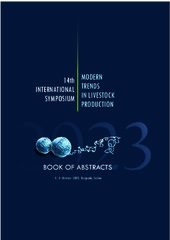Приказ основних података о документу
Aflatoxin and fumonisin contamination of maize grains harvested during 2018–2022 in Serbia
| dc.creator | Krnjaja, Vesna | |
| dc.creator | Stanković, Slavica | |
| dc.creator | Obradović, Ana | |
| dc.creator | Mandić, Violeta | |
| dc.creator | Petrović, Tanja | |
| dc.creator | Stanišić, Nikola | |
| dc.creator | Delić, Nikola | |
| dc.date.accessioned | 2023-10-11T07:34:06Z | |
| dc.date.available | 2023-10-11T07:34:06Z | |
| dc.date.issued | 2023 | |
| dc.identifier.isbn | 978-86-82431-81-7 | |
| dc.identifier.uri | http://r.istocar.bg.ac.rs/handle/123456789/904 | |
| dc.description.abstract | Maize is a staple food worldwide, used in human nutrition and as the main component of livestock feed. It contains nutrients such as carbohydrates (sugars and starch), proteins, fibres, minerals and vitamins and has the highest polysaccharide starch content (more than 70%). Maize grains are a suitable substrate for fungal infection and are frequently contaminated by the species from the Aspergillus and Fusarium genera. These fungi produce toxic secondary metabolites named mycotoxins. Aflatoxins (AFs) and type-B fumonisins (FBs) are the most detected mycotoxins in maize grains. Maize intoxication with AFs and FBs can lead to human and animal health disorders, causing acute and chronic mycotoxicosis. Aflatoxins produced by Aspergillus spp. have immunosuppressive, carcinogenic, and hepatotoxic properties and induce growth impairments. Fumonisins produced primarily by Fusarium spp. have neurotoxic, nephrotoxic, and hepatotoxic effects in animals and are classified as potentially carcinogenic in humans. The co-occurrence of AFs and FBs in maize has synergistic toxicological effects and poses a greater risk to human and animal health. The natural occurrence AFs and FBs in 65 maize grain samples collected during harvest in 2018 (13 samples), 2019 (11 samples), 2020 (9 samples), 2021 (14 samples) and 2022 (18 samples) was evaluated using the enzyme-linked immune sorbent assay (ELISA). The average levels of AFs and FBs in mycotoxin positive samples were 3.02 and 2910 µg kg–1 (2018), 5.28 and 2710 µg kg–1 (2019), 2.35 and 10980 µg kg–1 (2020), 6.81 and 4950 µg kg–1 (2021) and 5.32 and 20310 µg kg–1 (2022), respectively. The co-occurrence of AFs and FBs was detected in 23.08% (2018), 18.18% (2019), 22.22% (2020), 64.29% (2021) and 22.22% (2022) of maize samples. The maximum limits of 10 µg kg–1 for AFs in maize and 4000 µg kg–1 for FBs in unprocessed maize, prescribed by regulations of the European Union and Serbia, were exceeded for AFs in 14.29% (2021) and 5.56% (2022) of tested maize samples and for FBs in 7.69% (2018), 66.67% (2020), 28.57% (2021) and 41.67% (2022) tested maize samples. These results indicate the need for continuous monitoring of the health status of harvested maize grains and risk assessment of the potential presence of mycotoxins in the food chain to avoid adverse effects on human and animal health. | sr |
| dc.language.iso | en | sr |
| dc.publisher | Institute for Animal Husbandry, Belgrade-Zemun, Serbia | sr |
| dc.relation | info:eu-repo/grantAgreement/MESTD/inst-2020/200022/RS// | sr |
| dc.relation | info:eu-repo/grantAgreement/MESTD/inst-2020/200040/RS// | sr |
| dc.relation | info:eu-repo/grantAgreement/MESTD/inst-2020/200116/RS// | sr |
| dc.rights | openAccess | sr |
| dc.rights.uri | https://creativecommons.org/licenses/by/4.0/ | |
| dc.source | Book of Abstracts of the 14th International Symposium „Modern Trends in Livestock Production“, 4 – 6 October 2023, Belgrade, Serbia. | sr |
| dc.subject | maize; | sr |
| dc.subject | aflatoxin; | sr |
| dc.subject | fumonisin; | sr |
| dc.title | Aflatoxin and fumonisin contamination of maize grains harvested during 2018–2022 in Serbia | sr |
| dc.type | conferenceObject | sr |
| dc.rights.license | BY | sr |
| dc.citation.spage | 79 | |
| dc.citation.epage | 79 | |
| dc.identifier.rcub | https://hdl.handle.net/21.15107/rcub_ristocar_904 | |
| dc.identifier.fulltext | http://r.istocar.bg.ac.rs/bitstream/id/4292/bitstream_4292.pdf | |
| dc.type.version | publishedVersion | sr |


